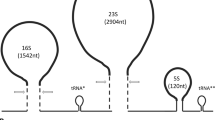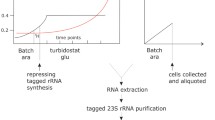Abstract
The bacterial ribosome is an important target for many antimicrobial agents. Aminoglycoside antibiotics bind to both 30S and 50S ribosomal subunits, inhibiting translation and subunit formation. During ribosomal subunit biogenesis, ribonucleases (RNases) play an important role in rRNA processing. E. coli cells deficient for specific processing RNases are predicted to have an increased sensitivity to neomycin and paromomycin. Four RNase mutant strains showed an increased growth sensitivity to both aminoglycoside antibiotics. E. coli strains deficient for the rRNA processing enzymes RNase III, RNase E, RNase G or RNase PH showed significantly reduced subunit amounts after antibiotic treatment. A substantial increase in a 16S RNA precursor molecule was observed as well. Ribosomal RNA turnover was stimulated, and an enhancement of 16S and 23S rRNA fragmentation was detected in E. coli cells deficient for these enzymes. This work indicates that bacterial RNases may be novel antimicrobial targets.





Similar content being viewed by others
References
Arraiano CM, Yancey SD, Kushner SR (1988) Stabilization of discrete mRNA breakdown products in ams pnp rnb multiple mutants of Escherichia coli K-12. J Bacteriol 170:4625–4633
Arya DP (ed) (2007) Aminoglycoside antibiotics. Wiley, Hoboken
Babitzke P, Granger L, Olszewski J, Kushner SR (1993) Analysis of mRNA decay and rRNA processing in Escherichia coli multiple mutants carrying a deletion in RNase III. J Bacteriol 175:229–239
Borovinskaya MA, Pai RD, Zhang W, Schuwirth BS, Holton JM, Hirokawa G, Kaji H, Kaji A, Cate JH (2007) Structural basis for aminoglycoside inhibition of bacterial ribosome recycling. Nat Struct Mol Biol 14:727–732
Brosius J, Dull TJ, Noller HF (1980) Complete nucleotide sequence of a 23S ribosomal RNA gene from Escherichia coli. Proc Natl Acad Sci USA 77:201–204
Cairrão F, Arraiano CM (2006) The role of endoribonucleases in the regulation of RNase R. Biochem Biophys Res Commun 343:731–737
Champney WS (2006) The other target for ribosomal antibiotics: inhibition of bacterial ribosomal subunit formation. Infect Disord Drug Targets 6:377–390
Champney WS (ed) (2008) New antibiotic targets. Humana Press Inc., Totowa
Champney WS, Tober CL (2000) Specific inhibition of 50S ribosomal subunit formation in Staphylococcus aureus cells by 16-membered macrolide, lincosamide, and streptogramin B antibiotics. Curr Microbiol 41:126–135
Chen C, Deutscher MP (2010) RNase R is a highly unstable protein regulated by growth phase and stress. RNA 16:667–672
Cheng ZF, Deutscher MP (2003) Quality control of ribosomal RNA mediated by polynucleotide phosphorylase and RNase R. Proc Natl Acad Sci USA 100:6388–6393
Davies J, Davies D (2010) Origins and evolution of antibiotic resistance. Microbiol Mol Biol Rev 74:417–433
Davies BW, Köhrer C, Jacob AI, Simmons LA, Zhu J, Aleman LM, Rajbhandary UL, Walker GC (2010) Role of Escherichia coli YbeY, a highly conserved protein, in rRNA processing. Mol Microbiol 78:506–518
Deutscher MP (2009) Maturation and degradation of ribosomal RNA in bacteria. Prog Mol Biol Transl Sci 85:369–391
Długosz M, Trylska J (2009) Aminoglycoside association pathways with the 30S ribosomal subunit. J Phys Chem B 113:7322–7330
Donovan WP, Kushner SR (1986) Polynucleotide phosphorylase and ribonuclease II are required for cell viability and mRNA turnover in Escherichia coli K-12. Proc Natl Acad Sci USA 83:120–124
Eidem TM, Roux CM, Dunman PM (2012) RNA decay: a novel therapeutic target in bacteria. Wiley Interdiscip Rev RNA 3(3):443–454
Foster C, Champney WS (2008) Characterization of a 30S ribosomal subunit assembly intermediate found in Escherichia coli cells growing with neomycin or paromomycin. Arch Microbiol 189:441–449
Frazier AD, Champney WS (2012a) Inhibition of Ribosomal Subunit Synthesis in Escherichia coli by the vanadyl ribonucleoside complex. Arch Microbiol (In Submission)
Frazier AD, Champney WS (2012b) The vanadyl ribonucleoside complex inhibits ribosomal subunit formation in Staphylococcus aureus. J Antimicrob Chemother 67(9):2152–2157
Gesteland RF (1966) Isolation and characterization of ribonuclease I mutants of Escherichia coli. J Mol Biol 16:67–84
Gutgsell NS, Jain C (2012) Role of precursor sequences in the ordered maturation of E. coli 23S ribosomal RNA. RNA 18:345–353
Hirokawa G, Nijman RM, Raj VS, Kaji H, Igarashi K, Kaji A (2005) The role of ribosome recycling factor in dissociation of 70S ribosomes into subunits. RNA 11:1317–1328
Jett BD, Hatter KL, Huycke MM, Gilmore MS (1997) Simplified agar plate method for quantifying viable bacteria. Biotechniques 23:648–650
Kaczanowska M, Rydén-Aulin M (2007) Ribosome biogenesis and the translation process in Escherichia coli. Microbiol Mol Biol Rev 71:477–494
Kushner SR, Maples VF, Champney WS (1977) Conditionally lethal ribosomal protein mutants: characterization of a locus required for modification of 50S subunit proteins. Proc Natl Acad Sci USA 74:467–471
Lee K, Bernstein JA, Cohen SN (2002) RNase G complementation of rne null mutation identifies functional interrelationships with RNase E in Escherichia coli. Mol Microbiol 43:1445–1456
Li Z, Pandit S, Deutscher MP (1999) RNase G (CafA protein) and RNase E are both required for the 5′ maturation of 16S ribosomal RNA. EMBO J 18:2878–2885
Mehta R, Champney WS (2002) 30S ribosomal subunit assembly is a target for inhibition by aminoglycosides in Escherichia coli. Antimicrob Agents Chemother 46:1546–1549
Mehta R, Champney WS (2003) Neomycin and paromomycin inhibit 30S ribosomal subunit assembly in Staphylococcus aureus. Curr Microbiol 47:237–243
Rio DC, Ares M Jr, Hannon GJ, Nilsen TW (2011) RNA: a laboratory manual. Cold Spring Harbor Protocols, New York
Rosen T (2011) Antibiotic resistance: an editorial review with recommendations. J Drugs Dermatol 10:724–733
Scheunemann AE, Graham WD, Vendeix FA, Agris PF (2010) Binding of aminoglycoside antibiotics to helix 69 of 23S rRNA. Nucleic Acids Res 38:3094–3105
Schroeder R, Waldsich C, Wank H (2000) Modulation of RNA function by aminoglycoside antibiotics. EMBO J 19:1–9
Silvers JA, Champney WS (2005) Accumulation and turnover of 23S ribosomal RNA in azithromycin-inhibited ribonuclease mutant strains of Escherichia coli. Arch Microbiol 184:66–77
Song WS, Lee M, Lee K (2011) RNase G participates in processing of the 5′-end of 23S ribosomal RNA. J Microbiol 49:508–511
Sutcliffe JA (2005) Improving on nature: antibiotics that target the ribosome. Curr Opin Microbiol 8:534–542
Usary J, Champney WS (2001) Erythromycin inhibition of 50S ribosomal subunit formation in Escherichia coli cells. Mol Microbiol 40:951–962
Wallis MG, Schroeder R (1997) The binding of antibiotics to RNA. Prog Biophys Mol Biol 67:141–154
Weatherford SC, Rosen L, Gorelic L, Apirion D (1972) Escherichia coli strains with thermolabile ribonuclease II activity. J Biol Chem 247:5404–5408
Zinner SH (2007) Antibiotic use: present and future. New Microbiol 30:321–325
Acknowledgments
Mutant RNase-deficient E. coli strains were gifts from Dr. Murray Deutscher (University of Miami) and Dr. Sidney Kushner (University of Georgia). This research was supported by an NIH AREA grant and an ETSU Graduate School research grant.
Author information
Authors and Affiliations
Corresponding author
Additional information
Communicated by Erko Stackebrandt.
Rights and permissions
About this article
Cite this article
Frazier, A.D., Champney, W.S. Impairment of ribosomal subunit synthesis in aminoglycoside-treated ribonuclease mutants of Escherichia coli . Arch Microbiol 194, 1033–1041 (2012). https://doi.org/10.1007/s00203-012-0839-5
Received:
Revised:
Accepted:
Published:
Issue Date:
DOI: https://doi.org/10.1007/s00203-012-0839-5




